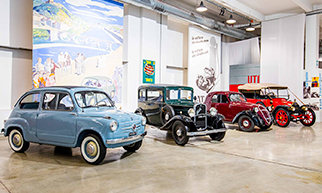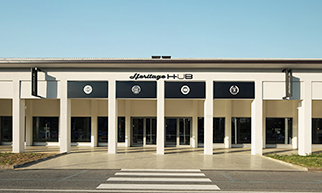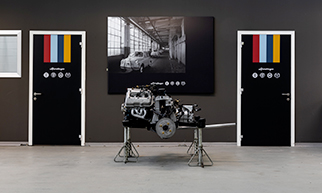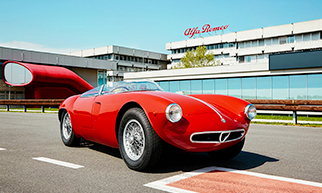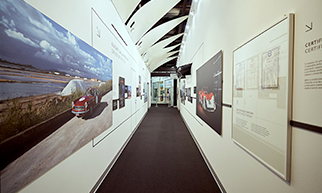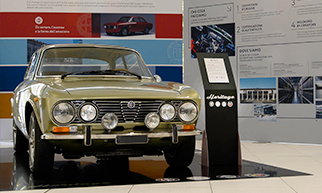The successor to the A112, the Autobianchi brand remains on the domestic market, but abroad it sports the “Lancia” badge on the grille, the first sign of a leap in quality. An elite compact car, very popular not only with women, but also with a wide range of generations, young and old alike.
At the 1985 Geneva Motor Show, the successor to the A112 made its debut: theAutobianchi Y10. It would become the final car with this brand. The Fiat Group thus prepared the transition that would lead to the creation, definitively under the Lancia brand, of the future Y ten years later.
From the Autobianchi A112 it took up the baton of a wonderful compact car, referred to as “elite”, already the name of one of the trim levels. Small and agile not only in the city, it offered high-end sedan finishes and interior materials. With that slightly snobbish understatement, it was immediately loved by those who wanted to stand out, not only by women, who preferred it for its elegant practicality.
The Fiat Group's attention to this car – small in size but premium in its specifications – was immediately evident from the decision to task it with the debut of new technologies. The first – and definitely the most important – was the new engine from the FIRE (Fully Integrated Robotised Engine) family: a four-cylinder 999-cc that delivered 45 hp. Produced at the Termoli plant using innovative techniques and with the extensive use of robots for assembly, it would become the basis of most of the Group's four-cylinder engines. A simple, reliable, efficient engine, economical in terms of both construction and performance.
The line of the Y10 was wedge-shaped, with a sloping bonnet and windscreen. The passenger compartment was also taller and the large glazed surfaces gave a greater feeling of space inside: the rear window was as large as the windscreen and had a compass opening available with electric control, an exclusive option for the segment.
The most original styling cue, at the same time the most debated, was the tailgate: practically vertical in matte black resin, regardless of the body colour, beyond a few special versions of the latest series on which the decoration with “CBS” (Cubic Printing System) has been tested.
The platform was based on the Fiat Panda, but the chassis offered greater comfort given the different suspensions at the rear that used the “omega” axle with coil springs instead of the rigid axle on leaf springs of the first Panda series.
At its debut, in addition to the FIRE engine, the Y10 was also equipped with the consolidated 1049-cc “Brazil” engine that delivered 56 hp in the naturally aspirated version, known as “Touring”. For those looking for performance, an 84-hp Turbo version was also available. Both sported even more luxurious interiors, with Alcantara elements to further ennoble the two top trims. In 1986 came the first injection of new luxury specifications, including electric window lifts, which also involved the FIRE-powered version in the new LX trim.
Sales grew, especially from Lancia dealerships, and the Y10 would soon become the perfect second family car, purchased to meet wives' needs for mobility, but often pinched by their children, husband and even grandfather. This practice also became the common thread of certain advertising campaigns that contributed to the increase in its success.
From the challenging all-wheel drive version to the Italian luxury brand models: the Y10 thus paved the way for the definitive transition to the Lancia brand, which occurred in 1995 with the presentation of the new small premium car: the Lancia Y.
One of the greatest innovations was the creation of the FIRE 4WDversion: an adaptation of the driveline of the Panda 4x4 and built in conjunction with Austria's Steyr, it also had electro-pneumatic control for engaging rear-wheel drive, instead of the lever seen in the Panda. Tyres with larger blocks, specific rims and interior fittings, mudflaps and resin side body protections completed the transformation into the perfect car for weekends out of town.
Even more than the Panda 4x4, the small Y10 4WD became the car for weekends in the mountains: with a ski rack on the roof and a boot big enough for four pairs of boots, the agility of the Y10 embarrassed the large Japanese 4x4s that had become all the rage in prestigious ski resorts, not only in the Alps. The very agile Y10 4WD often managed better than heavier, bulkier off-road vehicles.
From 1987 onwards, the FIRE engine evolved into the version with a catalytic converter and electronic injection for the two models: LX and 4WD. In 1989, the displacement rose to 1,108 cc and all FIREs only then came with electronic injection and catalytic converter: the output had been increased to 56 hp and the Touring version was definitively retired. To remain within the scope of the higher segment specifications, the automatic continuous variable transmission (CVT) made its debut in the Selectronic version. In 1989 came the GT version with a 1.3-litre, to replace the Turbo. 1,301 cc and direct injection for 75 hp or 1,297 cc, if with a catalytic converter, for 72 hp.
Several special versions were produced: from the Y10 Fila, in conjunction with the Biella sports textile company, and the Missoni with interiors that used velvet and designs typical of the fabrics from the well-known Italian brand, to the Y10 Turbo with Martini livery that echoed the colours of the winning Lancia rally cars.
In 1992, the second series was created: the grille was even closer to the Lancia style, taking up the stylistic feature of the badge, a true “family feeling” for the entire range from the Turin manufacturer. The headlights were also different, but the end result remained unchanged. There was a wider variety of trim levels, with the Elite and Avenue versions, later joined by the Mia, Junior and Selectronic Ville. At the end of its career, in 1995 when its successor the Lancia Y had already come to be, the 1.1 gained 5 hp without increasing consumption. The 4WD remained in the range but with a more elegant and less heavy-duty line, without the protections in the lower part of the doors but with the same changes to the grille and light clusters as throughout the range. The leading model in terms of output remained the 72-hp 1.3, available in the Elite trim only.
The transition to the Lancia Y took place in November 1995: the personality of the new small Lancia was particularly pronounced, thus further enhancing the premium/compact combination, taking as a starting point the infinite range of colours available: the “Kaleidos” colour customisation programme included 100 shades to choose from. The leap in quality was also remarkable in terms of interior space, with the use of the Fiat Punto platform from which it also inherited the evolution of the FIRE, which would continue to improve in terms of displacement, efficiency and low emissions. The tradition of special versions continued, with the “Elefantino Blu” (‘little blue elephant’) a standout. In 2006, the second series was created and extended the name to the Lancia Ypsilon, renewed again in 2011 with a very high beltline that also featured in the now more inclined glass surfaces, and with the addition of rear doors.
